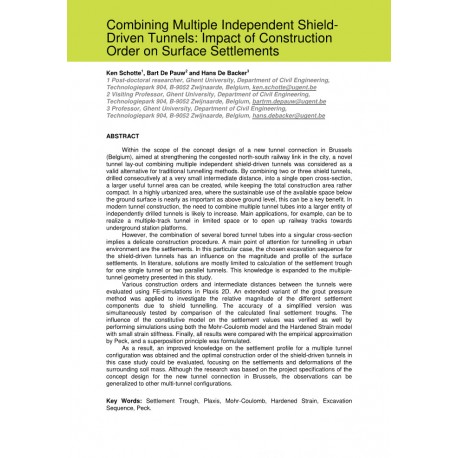Cart
0
0
No document
0,00 €
Total
Document successfully added to your shopping cart
Quantity
Total
There are 0 items in your cart.
There is 1 item in your cart.
Total documents
Total shipping
To be determined
Total
Search & filter
Search for a publication
Search & filter
Combining Multiple Independent Shield Driven Tunnels: Impact of Construction Order on Surface Settlements
3518_combining_multiple_independ
K. Schotte / H. De Backer / B. De Pauw
Within the scope of the concept design of a new tunnel connection in Brussels (Belgium), aimed at strengthening the congested north-south railway link in the city, a novel tunnel lay-out combining multiple independent shield-driven tunnels was considered as a valid alternative for traditional tunnelling methods. By combining two or three shield tunnels, drilled consecutively at a very small intermediate distance, into a single open cross-section, a larger useful tunnel area can be created, while keeping the total construction area rather compact. In a highly urbanized area, where the sustainable use of the available space below the ground surface is nearly as important as above ground level, this can be a key benefit. In modern tunnel construction, the need to combine multiple tunnel tubes into a larger entity of independently drilled tunnels is likely to increase. Main applications, for example, can be to realize a multiple-track tunnel in limited space or to open up railway tracks towards underground station platforms. However, the combination of several bored tunnel tubes into a singular cross-section implies a delicate construction procedure. A main point of attention for tunnelling in urban environment are the settlements. In this particular case, the chosen excavation sequence for the shield-driven tunnels has an influence on the magnitude and profile of the surface settlements. In literature, solutions are mostly limited to calculation of the settlement trough for one single tunnel or two parallel tunnels. This knowledge is expanded to the multipletunnel geometry presented in this study. Various construction orders and intermediate distances between the tunnels were evaluated using FE-simulations in Plaxis 2D. An extended variant of the grout pressure method was applied to investigate the relative magnitude of the different settlement components due to shield tunnelling. The accuracy of a simplified version was simultaneously tested by comparison of the calculated final settlement troughs. The influence of the constitutive model on the settlement values was verified as well by performing simulations using both the Mohr-Coulomb model and the Hardened Strain model with small strain stiffness. Finally, all results were compared with the empirical approximation by Peck, and a superposition principle was formulated. As a result, an improved knowledge on the settlement profile for a multiple tunnel configuration was obtained and the optimal construction order of the shield-driven tunnels in this case study could be evaluated, focusing on the settlements and deformations of the surrounding soil mass.




